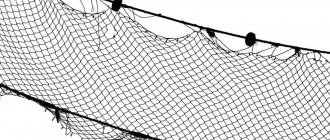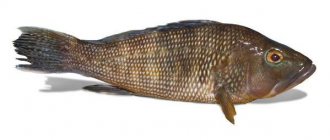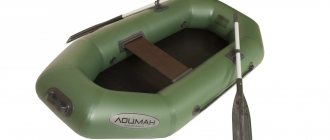The first signs of a drowning person
Before you rush into the water to save a drowning person, you need to make sure that the person is really drowning. How can this be recognized from the shore?
- The position of a drowning person's body is usually vertical.
- His hands are raised up, and he seems to be trying to grab something with them. But in reality he just splashes his hands on the water.
- The head rises above the water and then disappears.
- At first, a person can scream and call for help, but if he no longer has the strength, he remains silent. Children almost always do not scream, but simply open their mouths wide in horror, trying to grab air.
- If a person does not answer the question: “Are you all right?”, then this is a sign of trouble that has happened to him.
First actions of the rescuer
Before you rush to save a drowning man, you need to think about the situation. Be sure to ask someone to call water rescue and emergency services. If possible, you need to quickly take off your clothes. If this cannot be done, then you need to at least turn the pockets outward. Be sure to take off your shoes. After all, water quickly accumulates, which interferes with movements and pulls strongly to the bottom.
It makes sense to throw yourself into the water to save a drowning person if the rescuer can swim well. Health allows you to withstand strong loads, since a drowning person can instinctively grab his rescuer tightly, hit him, pull him to the bottom, and drown him. You need to be prepared for such a turn of events and know how to get out of the strong hands of a desperate person.
You also need to check where it is best to start rescuing a drowning person. It is advisable to choose the closest point on the shore. It is better to run more along the shore than to swim further on the water. You should also not jump into the water in an unfamiliar place, as there may be pitfalls there. Need to come in quickly.
When rescuing a person, take some kind of floating device with you: an inflatable ring, a ball, a board. Any object that a drowning person can grab onto will be useful. Otherwise, he will have to hold on only to you and it will be a problem to bring him to shore.
If you have to rescue a fisherman who has fallen under the ice, then you cannot approach him while standing, you must advance while lying on the ice. You can give him a long stick, a net, a ladder, or a whole fishing rod. You can create a chain of people lying on the ice and holding each other. This will be the safest way.
How to prevent drowning: actions when you see a drowning person
Call the rescuers
If you witness someone drowning, first of all evaluate your strength.
If you are not a very good swimmer and do not know the basic techniques for catching a drowning person, under no circumstances should you try to save a person by swimming to him.
Because a drowning person may well drag you to the bottom.
Call for help. If there are no lifeguards on the beach, get the attention of other people.
Throw a circle or air mattress
If a person is not far from the shore, you should try to extend your hand, some long object, or throw a life preserver.
To prevent a drowning person from dragging you into the water, lie on your stomach as close to the water as possible, spread your legs wide and extend a strong hand to the person in the water.
Because the drowning person is under the influence of adrenaline, he may not notice your hand.
Say it clearly and loudly, but without screaming hysterically, so that the person grabs your wrist.
This is very important because:
- Firstly, your task is to calm the victim, and not to scare him even more by yelling at him.
- Secondly, the wrist-wrist grip is the strongest and the risk of the hand slipping is reduced to zero.
If you cannot reach a drowning person with your hand or a long object, throw him a lifebuoy after tying it with a rope. You should loosely wrap the rope around the hand you are not using to throw the circle, and step on the end of the rope with your foot.
It is best to aim at the area behind the drowning person, and then simply pull the circle towards him. As you throw, allow the rope to swing freely, but be sure to secure the end with your foot.
It is important not to hit the drowning person in the head, as this will only make things worse. Yell at the person in the water to grab the circle. As soon as he does this, immediately pull him to the shore.
Swim up
You should only enter the water if there is no other way to help a drowning person.
You should minimize the distance to the drowning person along the shore and make sure that there are no whirlpools in the water.
It is better to take some kind of floating device with you (the same lifebuoy).
It is strictly forbidden to jump into the water or dive, as there may be pitfalls at the bottom.
You should also not go into the water with a running start - save your strength, you will need it later.
Before entering the water, you must take off your shoes and outerwear, and turn out your pockets (otherwise water will accumulate in them, making movement difficult).
It is important to remember that even if you are strong enough to swim to a drowning person, you will also need to deliver him to the shore. So swim fast, but save your strength. To reach a person in the water as quickly as possible, swim freestyle.
The first reaction of a drowning person will be to climb onto the rescuer. To prevent this from happening and both of them going to the bottom, you should swim up to him from below and from behind, grabbing his shoulder or hair, and pulling his head to the surface.
This method will protect you from catching a drowning person and at the same time provide him with air. Order to grab the circle and immediately start moving towards the shore - your strength is not unlimited.
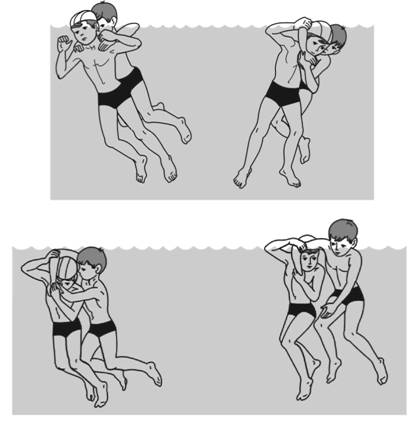
Look behind you from time to time to make sure the person is still holding on to the circle. Upon reaching the shore, help the drowning person get out of the water.
https://youtu.be/XVsKLzCDzP4
How to provide assistance correctly?
To quickly swim to a drowning person, it is better to use the crawl style of swimming. You should always approach the victim from behind. Since a person experiencing a panic state is able to hit you, start drowning you, block your movements and pose a threat. This must be remembered and guarded against.
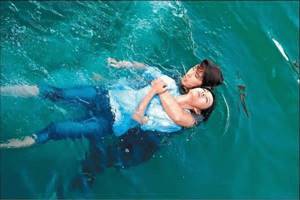
If you can’t swim up to him from behind, then you need to dive under the person and grab him tightly under the knee. With your free hand, sharply push the other knee forward and, thus, turn the victim’s back to you.
When the drowning person is already with his back to you, you need to grab his right armpit with your right hand and, holding it tightly, float to the surface of the water. You need to move towards the shore on your back, supporting the person’s head above the water.
Capturing and transporting a drowning person
Methods of transportation depend only on the condition of the person who is drowning.
If the drowning person remains relatively calm, can control his body and obeys the advice of the person saving him, then he can be brought to land using this method: you need to swim on your stomach with breaststroke, and the drowning person should hold on to the rescuer’s shoulder, while lying on the water and helping The rescuer moves forward with small jerks with his legs.
If the person who is drowning is in shock or panic and does not understand what is being said to him, then it is better to use the following types of transportation:
- Turn the person around and press him towards you, firmly grabbing him by the armpits or chin. Swim breaststroke on your back or side in this position.
- Turn the person's back to you and grab him by the armpits or head, swim breaststroke on your side in this position.
- Turn the person being rescued onto his back, grab him by the armpit with one hand and, clasping his forearm on the other side, swim on his side, rowing with his unoccupied arm and legs. This is the most difficult type of transportation and is used only when the drowning person is very scared.
- If a person is already submerged at the bottom of a reservoir, then he will need to dive and swim along the bottom where the victim may presumably be located.
- Having found a drowning person, you need to grab his armpits or arms, then push off with force from the bottom and emerge to the surface of the water, working as quickly as possible with your legs and unoccupied hand.
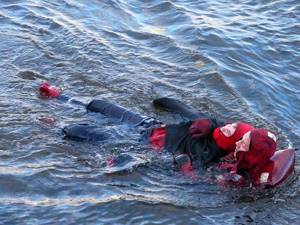
Having emerged, you should turn the person’s back to you and, without hesitating a minute longer, swim with him to the nearest shore:
- If a drowning person is at the bottom of a reservoir facing the bottom, then you need to swim to him from the feet.
- If he is at the bottom face up, then you need to approach him from the side of the head.
How to protect yourself?
Actions when rescuing a drowning person are associated with great risk. A drowning person is frightened, in a state of shock and may strongly grab his rescuer with his hands. This threatens the death of a person who wants to help. You need to be able to act correctly in such situations and, without losing your mind, use force to free yourself from the deadly embrace.
When getting rid of the grip, you need to twist, press on your chin, twist your arms in the opposite direction, but do not let go. You need to try to wriggle out sharply, while explaining and reassuring the person with words.
How to tow a drowning person to shore?
Methods for rescuing drowning people can be different, depending on the situation and how much the person resists and in what condition he is. As a rule, a person is towed while lying on his back or side. You can hold him by the head, armpits, by the arm in the shoulder area, by the hair or collar if he is wearing clothes.

When delivering a person to shore, you need to carefully ensure that his head is above the surface of the water at all times so that it does not get into his respiratory tract. When a rescuer swims sideways, he can navigate the terrain and choose the shortest route for rescue.
If the lifeguard had the opportunity to take life-saving equipment from the shore, such as a circle or a ball, that people have on the beach, then the drowning person must be forced to clasp them with his hands. Of course, if the person is still conscious.
Prevention of accidents on water
Any accident can be prevented. The same applies to drowning. The risk of going under water increases with the onset of warmer weather, when outdoor trips become frequent events. A good mood, a relaxed state, fueled by strong drinks, lead to carelessness on the water, and the risk of drowning increases significantly. Temperature changes can also be reasons for going underwater, when a person, having warmed up in the sun, suddenly plunges into the water and loses consciousness. If water is too cold, you may experience a cramp. To avoid drowning, listen to the following tips:
- When entering a body of water, do not swim too far. If this happens, and you understand that you won’t get back on your own, lie on your back, rest and call for help;
- Having decided to get to land on your own, give yourself as much rest as possible;
- If you don’t know how to swim, swim with inflatable flotation devices;
- do not let children go to the beach themselves;
- do not dive headfirst without knowing the bottom topography;
- It is not recommended to swim immediately after eating and especially after drinking alcohol;
- when resting on the mattress, make sure that it is not carried far from the shore;
- It is prohibited to swim near bridges, quarries, cliffs and in places with strong currents;
- Just in case, attach a safety pin to your swimsuit. You can use it if you suddenly have a cramp.
Remember that even a master of sports in swimming can drown. Caution on the water is not just empty words. Follow it, and then bathing will bring you and your family joy, not grief.
Types of drowning
The actions to take when rescuing a drowning person depend on the type of drowning. There are three types of them.
- White asphyxia, otherwise this type is also called imaginary drowning. From fear of water getting into the lungs, a person reflexively experiences a spasm, breathing stops and the heart stops. Such a drowned person can be revived after 20 minutes.
- Blue asphyxia occurs when water enters the alveoli of the lungs. It is easy to understand this by a person's appearance. The face, ears, lips, fingers acquire a purple tint to the skin. This one needs to be rescued urgently; the rescuer only has 5 minutes left.
- The next type of drowning occurs when there is depression of nervous processes. This happens under the influence of alcohol or hypothermia of the body. Rescue is given from 5 to 10 minutes.
Read also: Symptoms and treatment of dehydration in adults
First aid
When rescuing a drowning person, you must first check for breathing and a heartbeat. If vital signs are present, then you need to remove his wet clothes and lay him down so that his head is down or on his side. Cover with a warm blanket. If a person is able to drink, then you can give him a warm drink.
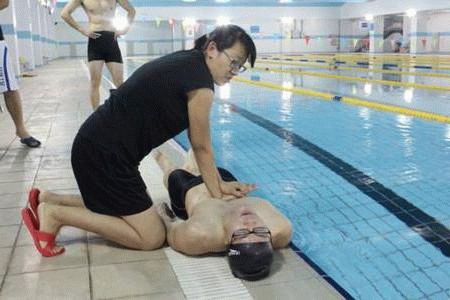
When a person is unconscious, you need to get down on one knee, put the person with his stomach on the other knee, head down. Try to clear the sand from his mouth and straighten his tongue forward to prevent it from sticking. The water that has entered the body should pour out. Only after this should resuscitation begin. According to the rules for rescuing a drowning person, you need to do artificial respiration and chest compressions.
First aid for a drowning person on land
When you pulled a drowning person to land, you should give him first aid :
- Examine the person. His mouth and nose can become clogged with algae, debris, and sand. It is necessary to quickly clean your mouth and nose. Lay your head on the side and use your fingers to clear your respiratory system of any contaminants.
- After this, position the person face down on your knee. Press with your hand between the shoulder blades, the water should begin to come out on its own. If this does not happen, press your fingers on the root of the tongue. This will trigger the gag reflex.
- We need to call an ambulance.
Important: If a person does not show any signs of life, there is no pulse, immediately begin resuscitation efforts.
Artificial respiration
It is difficult for an inexperienced person to perform artificial respiration, but you need to try. The easiest way is “mouth to mouth”.
- Place the victim on his back.
- Throw your head back.
- Close your nose and start breathing air into his mouth with your mouth.
In one minute you need to inhale about 12-14 times. This must be done until the breathing reflex starts and begins to work independently.
If water flows out of the victim’s mouth, the head must be turned to the side and supported.
Indirect cardiac massage
Along with artificial respiration, it is worth performing cardiac massage.
- Place your hands with your palms at the bottom of your chest.
- Press on the chest 50-70 times per minute.
- For 5 pushes - one breath.
It is advisable for two people to provide assistance. While one will do cardiac massage, the second will do artificial respiration.
It is quite difficult to carry out these activities without special training, but one cannot remain idle. Every attempt must be made to save a person.
Resuscitation measures
To carry out artificial respiration, a person is placed on a hard surface with a cushion under the neck. For a person to begin to breathe, his lungs must fill with air. To do this, the rescuer takes a deep breath, bends over the mouth of the drowned person and exhales into his respiratory tract. If the chest rises, it means that air has entered his lungs. This should be done every 1-2 seconds. There should be at least 30 exhalations per minute.
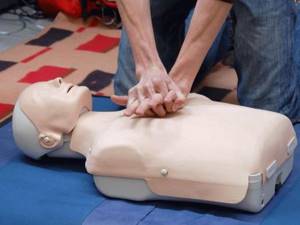
During breaks, cardiac massage is performed. It's better when it's done by a second person. The palms of two hands are placed on the person’s chest in the area of the heart, one on top of the other. Rhythmically and strongly pressing on the sternum. You need to do 15 presses in 10 seconds. Resuscitation continues until the person comes to his senses. This can happen for quite a long time. But under no circumstances should we stop. According to statistics, most of the rescued people did not survive only because resuscitation efforts were stopped.
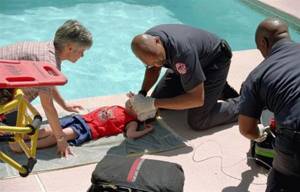
Be sure to call an ambulance, because rescuing a drowning person in the water is a lengthy process.
Rules for providing assistance on water
Basic means and methods of water rescue
The main means and methods of water rescue are:
- objects that increase a person’s buoyancy: lifebuoy, “Alexandrov’s end”, rescue balloons, boards;
- watercraft: boat, raft, air mattress;
- approaching a drowning person along the shore, or swimming, extracting him from the water.
If the victim is far from the shore and is capable of independent active actions, then he needs to throw one of the special life-saving equipment described below.
You need to take the lifebuoy with one hand, grab the lifeline (rope) with the other hand, make 2-3 circular movements with your outstretched arm at shoulder level and throw it flat towards the drowning person. The throw should be made so that the circle falls at a distance of 0.5-1.5 m from the person. You should not throw the circle directly at him - this can lead to injury. When throwing a circle from a boat, you need to do it from the stern or bow. The victim can hold on to a circle, a handrail, or wear a circle on his belt.
“Alexandrov’s End” should be taken by the large loop and made 2-3 turns of the rope, the small loop and the rest of the rope should be held in the other hand. After making several swings of the hand with a large loop, “Alexandrov’s end” is thrown to the victim. He, in turn, must put the loop over his head under his arms or hold him by the floats. After this, the victim is pulled to the shore.
You can grab the rescue balloons with one hand and grab the rope connecting them with the other hand. After completing 2-3 swings, throw the balls to the victim.
Watercraft. When assisting a drowning person, boats can be used. You need to approach the victim very carefully, taking into account the direction of the wind and current, so as not to injure him with the oar, boat hull, or motor. The victim can be lifted on board or transported to shore by water.
Most often, a drowning person has to be helped by swimming. This method requires rescuers to be able to swim well, dive, transport victims in the water, provide assistance, and know how to free themselves from grips.
Before entering the water, you need to quickly assess the situation, approach the drowning person along the shore, enter the water and swim towards him. If the victim controls his actions, he should hold on to the rescuer’s shoulders and swim to the shore with him. In case of uncontrolled behavior of a drowning person, it is necessary to approach him from the back, capture him and transport him to the shore. During transportation, the victim's head should be above the water.
If the victim has sank to the bottom of the reservoir and is lying with his back on the ground, then you need to swim up to him from the side of the head, grab him under the armpits, push off from the bottom and rise to the surface of the water. If the victim is located on his side or stomach, you need to swim to him from the legs. The search for a victim under water is carried out using a mask or special glasses, and if they are missing, you can open your eyes under water. If there is a current, the possibility of the victim being carried away must be taken into account.
The main condition for providing assistance to a drowning person is the prompt implementation of the entire range of work. This is due to the fact that after 5-6 minutes of being under water, irreversible processes begin in the body and the person dies.
It must be remembered that a drowning person poses a real threat to those who help him. Overcome by fear, he does not control his actions, makes chaotic movements, and can strongly grab a person nearby and plunge into the water together with him. Taking this into account, you need to swim up to a drowning person from the back, act clearly, unceremoniously, and, if necessary, harshly, try to avoid grabs. If this happens, you need to get rid of them as quickly as possible.
One of the reliable and effective ways of freeing oneself from grips is considered to be going underwater with the victim, who will definitely let go of the rescuer and try to rise to the surface to take a breath.
It is not uncommon for several drowning children to be in the water at the same time. In this situation, the most dangerous thing is that the rescuer is captured by several victims at the same time.
When approaching a group of drowning people, you need to select the victim who is in the most critical situation and provide assistance to him.
To maintain buoyancy in water, people need to throw floating objects. In order to speed up the rescue operation, it is advisable to use a boat. You need to swim to a drowning person against the current; in windy weather, against the wind and waves. If the boat is equipped with a motor, victims should be lifted into it from the stern. This must be done overboard. You need to squat or kneel in the boat, which will prevent it from rocking and prevent it from capsizing.
When lifting a victim onto a swimming craft, it is necessary to exclude the possibility of injury from sharp and protruding parts. If it is not possible to lift the victim onto the ship, he should throw a life-saving device.
The maximum permissible load of the boat should ensure a side height above the water surface of 25 cm. If the boat is operated in windy weather, at night, on an unknown body of water, the free side height above the water should be 50 cm.
After removing a person from the water, it is necessary to immediately begin providing first aid, the degree of which is determined taking into account the condition of the victim.
How to save a drowning person without drowning yourself?
We talk about the correct algorithm of actions in case of an emergency on the water.
— I saw your news about the men who saved a boy in Vyatka. And that there were no lifeguards on the beach at that time. A lot of people drown here during the summer, and I often go to the river. I would like to know what to do if you see a person drowning.
Let's start with the fact that swimming is officially permitted only on equipped beaches inspected by the Ministry of Emergency Situations. Swimming areas must be equipped with a rescue post, have visual limits to the swimming area (for example, buoys), and the bottom of the reservoir must be cleared. Otherwise, swimming in the reservoir is prohibited; you can only relax on the shore.
On this topic
“He was unconscious, his eyes were black, all the whites were covered in blood”: Kirov residents told how they rescued a boy who was drowning in Vyatka
2825
However, Kirov residents often neglect safety measures. Thus, since the beginning of the swimming season in the Kirov region, six people have already drowned, including children. Most of the accidents occurred in places where swimming is prohibited. However, there are exceptions: on July 14, two men rescued a 10-year-old boy drowning in Vyatka in the area of the city beach, where lifeguards were supposed to be there, but there were none. The city administration explained that lifeguards are on duty on the water in the area of the city beach only from 10 a.m. to 8 p.m. and only in warm, sunny weather. The rest of the time they only patrol the territory once an hour. Therefore, even on an officially equipped beach, rescuing drowning people can become the work of the drowning people themselves or other vacationers.
How to understand that a person is drowning
It is worth noting that recognizing a drowning person is not always easy. Contrary to popular belief, a drowning person will not loudly call for help, pull his arms out from under the water, or slam his hands on the water: all these signs are contrary to physiology. In order to scream, a person needs to breathe normally, and when drowning, their hands are instinctively used for something else: they are spread out to the sides to push off the water and swim upward.
Specialists from the State Inspectorate for Small Vessels of the Kirov Region identify the following signs of a drowning person:
- position of the mouth: in a drowning person, the head is usually immersed in water, and the mouth is located at the very surface and periodically goes under the water, then appears above the surface. So the body tries, while floating up, to inhale as much air as possible. Another position: the drowning person tilts his head back, opens his mouth;
- body position: a drowning person remains upright until the last moment. It may even seem as if the person is climbing an invisible rope ladder;
- hand position: drowning people cannot wave their hands to attract the attention of others. When they begin to drown, they instinctively stretch their arms out to the sides to push off the water. It doesn’t always work out, so if you see a person hitting the surface with his hands, be sure to check if everything is okay with him;
- gaze: most drowning people usually either close their eyes altogether, or stare blankly at one point, without focusing. Sometimes this may be the only sign of drowning. It is also worth paying attention to a person if his hair has covered his eyes, but he does not try to push it away.
If you see warning signs, call out to the person and ask if they are okay. If they don’t answer you or you get a blank look in response, you need to immediately begin rescue. But only if you know how to swim. If not, call for help.
Rescue technique
Having noticed a drowning person, determine if there is something at hand that can be thrown to the victim (rope, wooden board, lifebuoy, etc.). If there is nothing suitable, you should swim to the victim, after encouraging him with a shout.
When approaching a drowning person, you need to dive under him and, grabbing him from behind (you can grab him by the hair), swim to the shore. A drowning person may grab you by the arm, neck or legs. In this case, dive immediately - the instinct of self-preservation will force the victim to let you go.
If a person has already plunged into the water, do not stop trying to find him and then bring him back to life. This can be done even if the drowning person has been in the water for about 6 minutes.
Types of drownings
Having pulled the victim ashore, determine the type of drowning: the nature of first aid will depend on this. Drowning may be blue or pale, depending on the color of the victim’s skin.
Blue drowning occurs when a drowning person fights for his life until the last minute. Usually people who cannot swim or children who find themselves in the depths drown this way. With blue drowning, the victim’s skin becomes blue-gray, pinkish foamy liquid is released from the mouth, breathing becomes bubbling, frequent coughing with pinkish foamy sputum is characteristic, and the blood vessels of the neck swell greatly.
Pale drowning occurs when a person drowns unconscious (hits their head while diving or before falling into the water, loses consciousness from shock) or falls through the ice. At the same time, unlike blue drowning, water does not enter the lungs and stomach in large quantities, which increases the chances of saving the life of the victim. In case of pale drowning, the skin is gray, and there is no foam from the mouth and nose.
First aid to the victim
In case of blue drowning, the first thing to do is to throw the victim over the knee face down (a large person can be sharply lifted by the waist together), put two fingers in his mouth and sharply press on the root of the tongue to provoke a gag reflex and stimulate breathing.
On this topic
Where can and where can’t you swim in Kirov?
4543
If, after pressing on the root of the tongue, you heard the characteristic sound “E” and this was followed by gagging movements, if you saw the remains of eaten food in the water pouring out of your mouth, then in front of you is a living person with a preserved gag reflex. Indisputable evidence of this will be the appearance of a cough. For 5-10 minutes, continue to periodically press firmly on the root of the tongue until water stops coming out of the mouth and upper respiratory tract.
If, when pressing on the root of the tongue, the gag reflex does not appear, if there is no coughing or breathing movements, turn the person onto his back and immediately begin artificial respiration. You need to act similarly in case of pale drowning: you don’t need to waste time removing water from the lungs (there is none there), you need to immediately start artificial respiration.
If the victim has palpitations:
- kneel to the left of him, throw back the drowned man’s head as much as possible, open his mouth and plug his nostrils;
- take a deep breath, put your lips to the victim’s lips through a handkerchief or gauze (if you have them at hand) and exhale forcefully, count to four and repeat until breathing appears.
If there is no heartbeat
, artificial respiration must be combined with chest compressions:
- place the victim on a hard surface (it is useless to perform chest compressions on loose sand), kneel to his left, tilt the drowned person’s head back as far as possible, open his mouth and plug his nostrils;
- Place one palm across the lower part of the sternum (but not on the ribs!), the other - crosswise on top of the first. Press on the sternum so that it bends 3-5 cm and release. You need to bend with straight arms, strongly, with a push, using your body weight. After each blowing, do 4-5 pressures. Children and infants should not take a full breath to avoid rupture of the lungs. Children should apply pressure on the sternum with one palm, and for infants with two fingers;
- do 30 pressures, repeat the combination “2 breaths + 30 pressures” (for children the ratio is 2:15);
- do not stop resuscitation until emergency services arrive or until signs of life appear. It is possible to maintain life in a lifeless person through artificial respiration and cardiac massage for an hour.
As soon as the victim shows signs of life, place him on his side. He must remain in a stable condition until the ambulance arrives. Even if the victim’s relatives or friends insist on letting him go home, insist on an “emergency”: even after rescue, there remains a threat of repeated cardiac arrest, development of pulmonary edema, cerebral edema and acute renal failure. Only after 3-5 days can you be sure that the victim’s life is no longer in danger.
Rules of conduct on the water
To avoid a tragedy, the Ministry of Emergency Situations strongly recommends following the rules of safe behavior on water:
- You can swim only in permitted places; children must swim in the presence of adults, even if the child is not far from the shore;
- do not dive in unfamiliar places: there may be submerged logs, stones, snags, and metal rods at the bottom;
- do not play games in the water that involve grabbing;
- do not go into the water while drunk - this is the main cause of drownings;
- do not swim far from the shore without calculating your strength. This is dangerous even for good swimmers;
- do not swim up to passing ships, do not cling to them.
Briefly about the main thing:
- As a rule, a drowning person does not wave his arms or call for help, as is shown in films. In a drowning person, the head is usually immersed in the water, and the mouth is located at the very surface and periodically goes under the water and then appears on the surface; the body is in an upright position, the eyes are closed or the gaze is not focused.
- If you know how to swim, shout out to the drowning person and swim to him. Dive under it and, hugging it from behind, head towards the shore.
- Having pulled a person ashore, you need to quickly determine the type of drowning. In the case of blue drowning (this is the most common case), his lungs must be freed of water by pressing the root of the tongue with your fingers. If the victim does not show signs of life, immediately begin artificial respiration and chest compressions if there is no pulse.
- Continue resuscitation until the ambulance arrives. It is possible to keep the victim alive with artificial respiration for an hour.
- After a person begins to show signs of life, he needs to be placed on his side. He must be in a stable condition until doctors arrive.
If you have questions that you can't find the answer to, ask us and we will try to answer them.
Photo source: mchs.gov.ru

